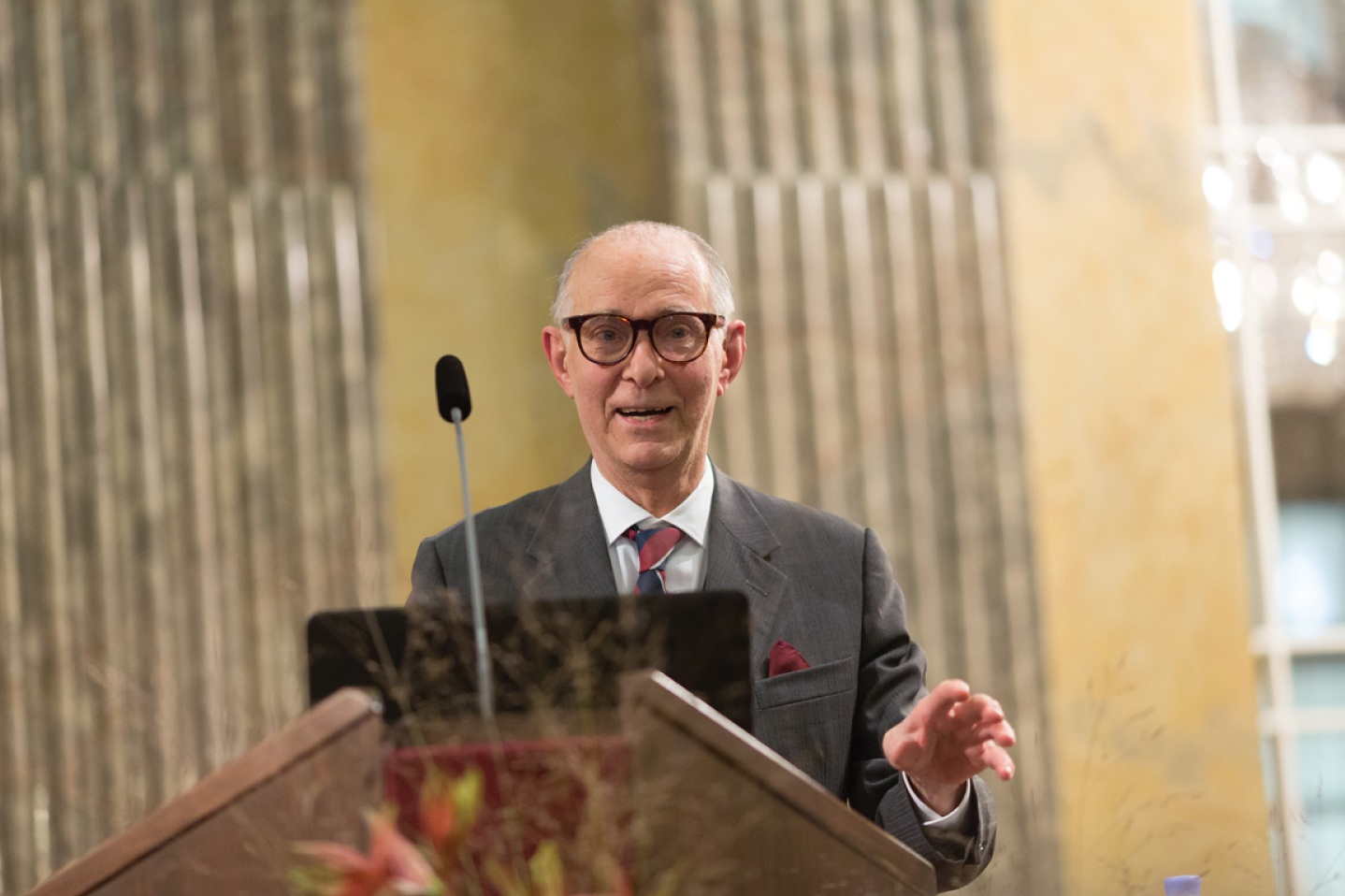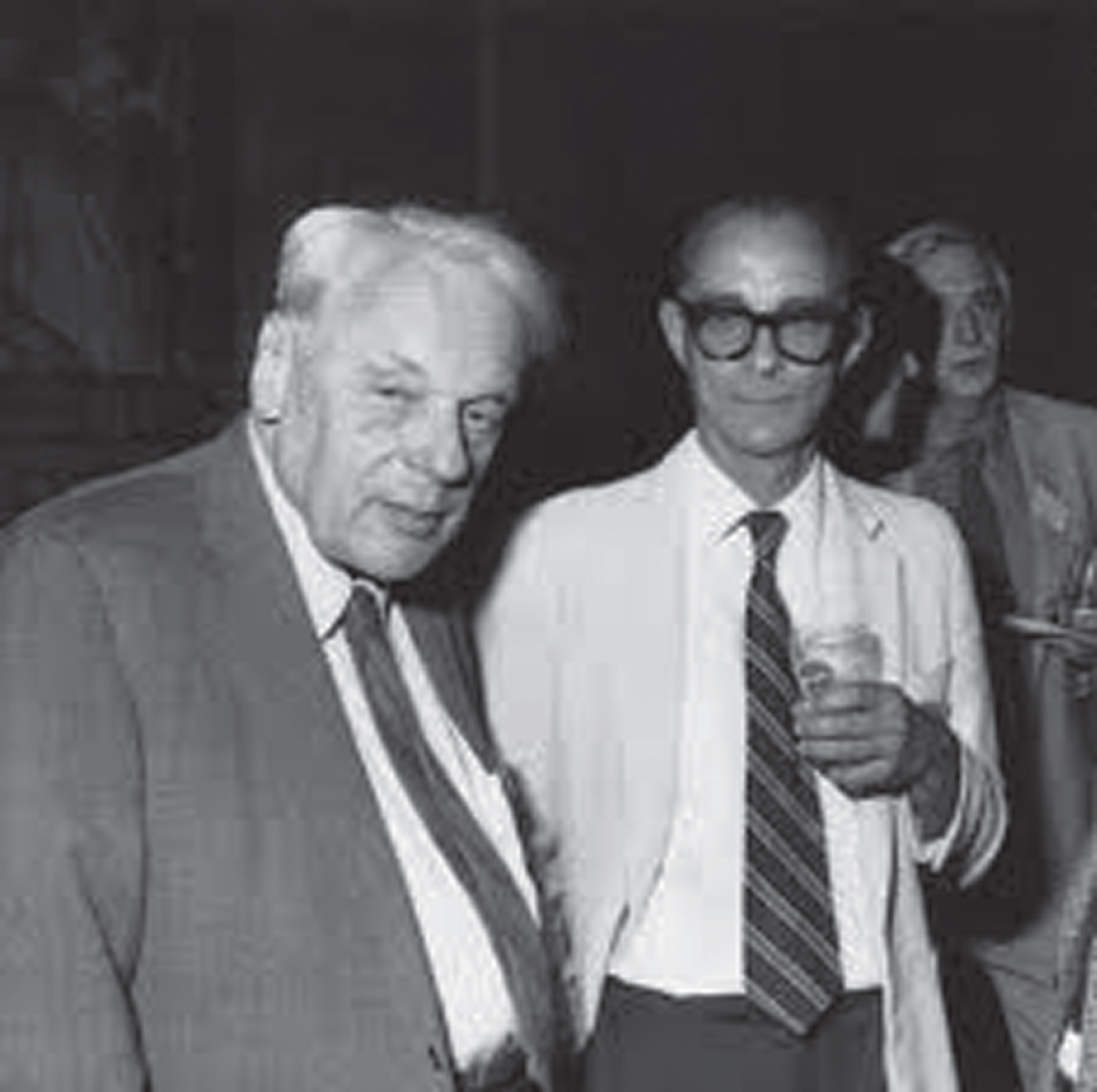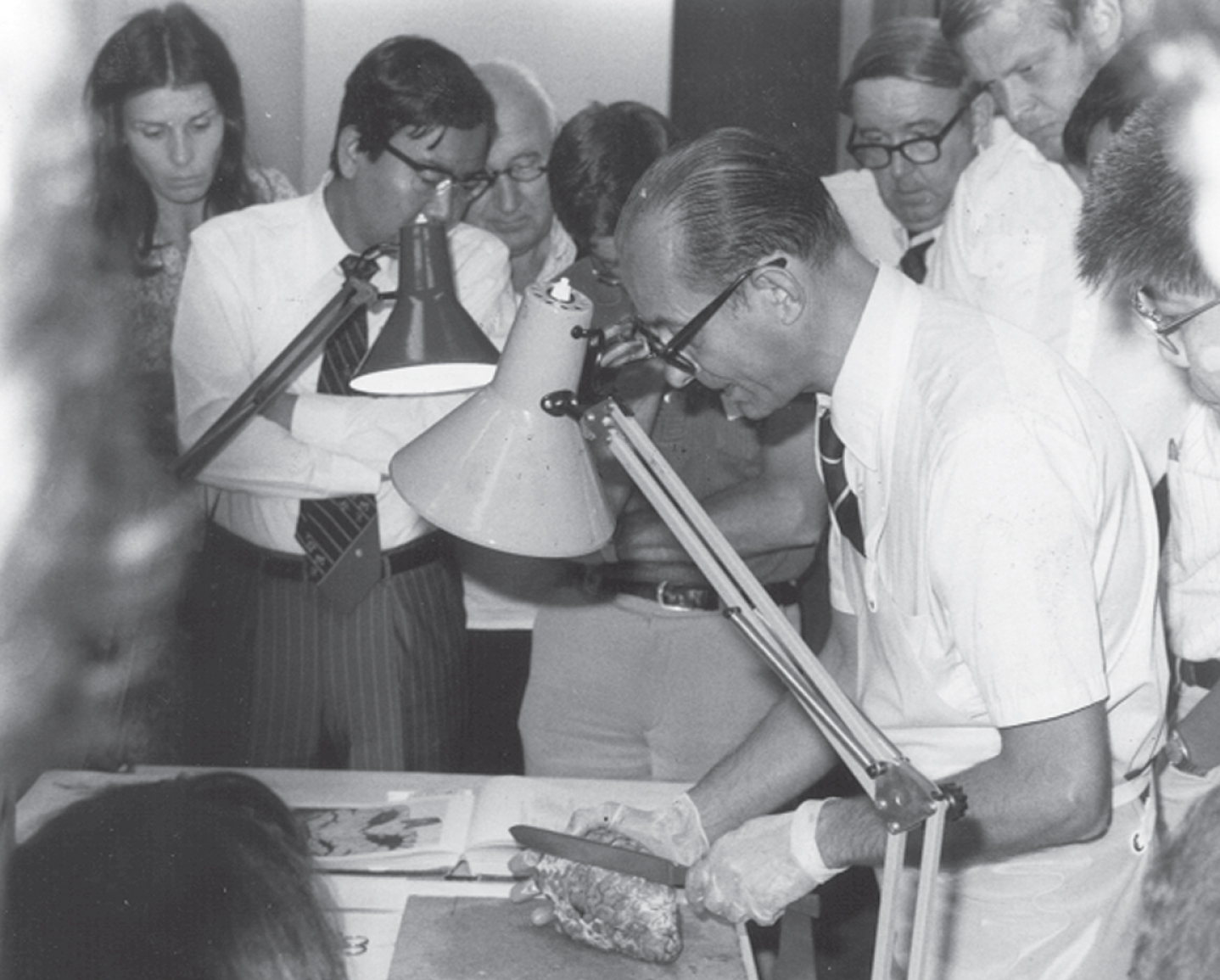Oleh Hornykiewicz (1926–2020)
Fondly I ponder you all:
without you I couldn’t have managed
even my weakest of lines
W.H. Auden (A Thanksgiving)
Fig.1
Oleh Hornykiewicz speaking at the Austrian Academy of Science during a symposium held in his honour to celebrate his 90th birthday in 2016.

Oleh Hornykiewicz continued to carry out human brain dissections into his tenth decade and was still discussing science with his customary infectious optimism up until a few weeks before his death at the age of 93. He will be most remembered for his discovery of dopamine depletion in the corpus striatum of Parkinson’s disease published with his collaborator Herbert Ehringer in Klinische Wochenschrift in 1960. These findings, which he attributed to loss of the ascending projections from nerve cells in the substantia nigra, were rapidly accepted by scientists around the world and in later studies he was able to show that the severity of bradykinesia and rigidity were inversely correlated with the level of dopamine in the dorsal putamen.
For many neurologists of our generation Hornykiewicz’s demonstration (together with the Viennese physician Birkmayer) of the potential of L-DOPA, the natural precursor of dopamine, to relieve the symptoms of Parkinson’s disease that was later confirmed by Cotzias and others represents the most significant therapeutic advance in neurology in the last fifty years. The story behind his momentous discovery, including the relative contributions of scientific and technological advancement and serendipity, the scepticism of Denny-Brown and Hassler, and how the Japanese scientist Isamu Sano was so close to getting there first has been honestly detailed by Hornykiewicz himself and others although there may yet be anecdotes and secrets to come out [1–3]. When asked if he was disappointed to have been overlooked for the 2000 Nobel Prize in medicine Hornykiewicz reacted with his customary modesty by stating that scientists do not work for prizes. He did regret, however, that the committee had implied that Arvid Carlsson had made the discovery that dopamine was lacking in the parkinsonian brain.
Oleh Hornykiewicz was born in the Galician town of Sychiv (now in Ukraine but at that time part of Poland) on November 17, 1926, the youngest of three sons of a priest of the Catholic-Ukranian church and teacher of Catholic doctrine and Philosophy of religion in Lviv. At the start of World War 2 the part of Poland where he lived came under the tyranny of Stalin and when he was thirteen the family fled to Vienna. By that time Hitler had annexed Austria to the German Reich and all new arrivals into Austria were given a copy of his notorious ‘Mein Kampf’, from which Hornykiewicz’ father used to read aloud to the family so they would learn German even though he strongly disapproved of the book’s ideology [4]. His paternal uncle had earlier taken residence in Vienna and was the priest at the only Greek Catholic church in the city so his father now became the chaplain making his living by teaching religion. Hornykiewicz was educated at Freud’s former alma mater, the Realgymnasium in Sperlgasse, an excellent school that had been predominantly a Jewish school before Hitler’s ascendancy, and – following his older brother – in 1945 enrolled as a medical student at the University of Vienna. He graduated in 1951 and made an early decision to go into full time scientific research rather than clinical practice, taking an honorary post in the inspirational Professor Franz von Brücke’s Pharmacology department, where he carried out post-doctoral research on the enzymatic properties of caeruloplasmin and confirmed that the protein was low in Wilson’s disease. This began his lifelong interest in the basal ganglia and the role of trace metals in human disease.
He was then awarded a British Council scholarship to work at the University of Oxford where he was offered a position in the biochemical pharmacology laboratory of Hermann Blaschko, a German Jewish emigré (Fig. 2).
Fig.2
Hermann Blaschko and Oleh Hornykiewicz.

Blaschko, in the course of his investigations into catecholamine synthesis, had come to suspect that 3 hydoxytyramine (dopamine), rather than being a mere precursor to noradrenaline, may have actions of its own. In 1956, Hornykiewicz was put to work to investigate dopamine’s possible cardiovascular effects in guinea pigs and after his return to the Pharmacological Institute in Vienna he continued to work on dopamine moving from the periphery to the brain. Intrigued by Bertler and Rosengren’s 1959 publication on the differential distribution of noradrenaline and dopamine in animal brains showing the highest dopamine concentrations in the striatum and their suggestion that dopamine depletion might underlie the parkinson-like symptoms seen after reserpine he began to collect the brains of people dying with Parkinson’s disease. As soon as he had found striatal dopamine depletion in the Parkinsonian brain he began to put pressure on his clinical colleague, Walther Birkmayer, to carry out some pilot studies with L-DOPA in Parkinson’s disease. The responses to a single doses of up to 150 mg administered intravenously were remarkable but in contrast to his pathological findings and despite cinematographic evidence showing the patients, improvement the report was greeted by physicians with scepticism, many erroneously attributing the effects to Birkmayer’s powers of persuasion. Nevertheless the report attracted a modicum of international interest, clinician researchers like Ted Sourkes from Canada and Melvin Yahr from New York came to Vienna to learn more about the ‘Dopa-Effekt’ and the final acceptance of L-DOPA as an efficacious drug in Parkinson’s disease occurred with the publication on the efficacy of chronic oral treatment by Cotzias and colleagues in 1967 [5].
In 1964 Hornykiewicz was awarded his ‘Universitätsdozent, and 3 years later he was offered and accepted the position of Professor and Head of the Department of Psychopharmacology at the Clarke Institute of Psychiatry at the University of Toronto in Canada. The facilities and funding were superior to those he had in Vienna but the decision to move across the Atlantic with a wife and four young children was not an easy one. Although he and the family settled well and he was very happy in his work, when his alma mater came calling in 1978 inviting (some have said requesting) him back to become the Head of a new Institute for Biochemical Pharmacology the professional temptation was irresistible. He insisted, however, on a contract that would allow him to continue to supervise the Human Brain Laboratory at the Clarke by spending several weeks each summer in Toronto. During his ten years in Canada he was able to confirm the existence of dopa decarboxylase in human brain and perform a number of important studies on catecholamines in regional brain areas in Huntington’s disease, dopa responsive dystonia and Lesch-Nyhan syndrome as well as Parkinson’s disease.
He remained Director of the Institute of Biochemical Pharmacology in Vienna until 1999 when it was subsumed under a larger Brain Research Institute of the Medical University where he maintained an office and continued to exercise his consummate skills in human brain dissection (Fig. 3) and pursue his research interests.
Fig.3
Oleh Hornykiewicz at an NIH sponsored Brain Dissection Seminar in Vienna in 1979. (courtesy Prof. G. Sperk, Innsbruck, Austria).

Even when dopamine was no longer a hot topic in the field of neurodegeneration he remained certain that continued study of the monoamines would provide other important insights of clinical relevance. The last paper he published as senior author in 2017 [6] is a salient example examining for the first-time monoamine transmitter levels in the human claustrum with dramatic loss of dopamine and noradrenaline in PD (Fig. 4). Further testimony comes from a paper published by his collaborators shortly before his death, that provides a detailed account of the sub-regional distribution of various neurotransmitters in the normal human striatum based on unpublished data from samples dissected by Hornykiewicz according to his elaborate three-dimensional scheme. His exemplary scientific standards are illustrated by his refusal to accept co-authorship since he felt he could no longer contribute to the writing or critical review of the manuscript.
Fig.4
Cover page of the journal issue with Hornykiewicz’ last publication showing his handwritten notes.

When asked about his hobbies in a 2007 interview he only mentioned two: ‘reading’ and ‘thinking’ and in the same interview, when asked if he considered himself a pharmacologist, a neurologist, a biochemist or a neuroanatomist, he added ‘a philosopher’. His reading interests went far beyond science, and anything that would add to understanding the human mind and existence excited his interest and critical reflection – Dante’s Divina Comedia being among his classical favourites. He loved classical music and was a regular visitor to the Opera and – although he has been quoted as saying that the significance of good food was grossly overestimated – he never lost his love for sweets and Viennese pastries. At a symposium dinner the eminent Catalan movement disorder specialist Eduardo Tolosa boasted that he was the world’s most avid consumer of desserts and challenged Oleh to a contest but was forced to admit defeat when the fourth dish arrived.
Hornykiewicz was a man of habit who arrived to work every morning dressed in a sober suit sporting a distinctive pair of double glasses in which the outer lenses would flip that were made specially for him at the ‘Universitätsoptiker’ shop in Vienna (Fig. 5).
Fig.5
Oleh Hornykiewicz in his Viennese office wearing his famous spectacles.

His lifelong routine ended abruptly one summer day in 2017 when seemingly out of the blue he informed his close collaborator Christian Pifl that he was going to take a holiday. He never came back and after that only left home to go to mass. This was also the year of his final publication. Those close to him believe that this change resulted from the grief experienced by the loss of his wife Christine who passed away in March of 2017. He continued to believe in the importance of human brain neurochemistry to the very end. When we both last spoke to him he was sceptical of the clinical meaningfulness of Braak’s findings, remained enthusiastic about neurotrophins and continued to believe that Parkinson’s disease was a single disease entity.
Up until shortly before his death he invited close colleagues and friends to visit him at home but he could only be contacted by telephone or fax and never used the internet arguing that the risks of being side tracked with useless information outweighed any benefits the world wide web might have in saving time. To those who met him he came over as modest and serious with piercing inquisitive eyes but he also laughed easily and had a playful sense of humour. He lost his hair when quite a young man and perhaps as a consequence of this, his trademark glasses, and his lithe and gracile physique, he seemed to remain physically unchanged for half a century.
Oleh Hornykiewicz, scientist, keeper of the faith and philosopher, died of old age on May 26, 2020. He leaves four children, seven grandchildren, one great-grandchild, a large number of colleagues and admirers around the globe, and millions of people with Parkinson’s disease whose lives have been transformed by his discoveries.
REFERENCES
[1] | Hornykiewicz O ((2002) ) Dopamine miracle: from brain homogenate to dopamine replacement. Mov Disord 17: (3), 501–508. |
[2] | Hornykiewicz O ((2017) ) L-Dopa. J Parkinsons Dis 7: (s1), S3–S10. |
[3] | Lees AJ , Tolosa E , Olanow CW ((2015) ) Four pioneers of L-dopa treatment: Arvid Carlsson, Oleh Hornykiewicz, George Cotzias, and Melvin Yahr. Mov Disord 30: (1), 19–36. |
[4] | Hornykiewicz O , Sommer BW ((2007) ) Interview with Oleh Hornykiewicz for the Movement Disorder Society’s Oral History Project conducted on February 9 2007. |
[5] | Cotzias CG , Van Woert MH , Schiffer LM ((1967) ) Aromatic amino acids and modification of parkinsonism. New Engl J Med 276: , 374–379. |
[6] | Sitte HH , et al. ((2017) ) Dopamine and noradrenaline, but not serotonin, in the human claustrum are greatly reduced in patients with parkinson’s disease: possible functional implications. Eur J Neurosci 45: , 192–197. |




